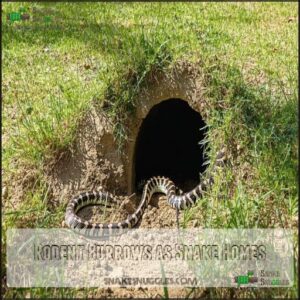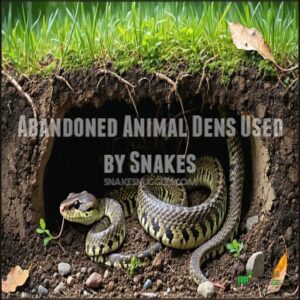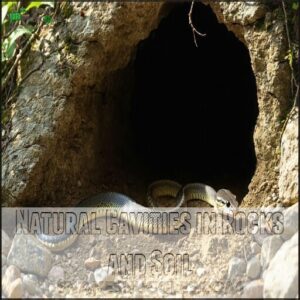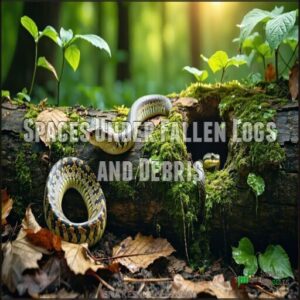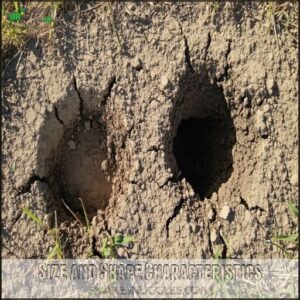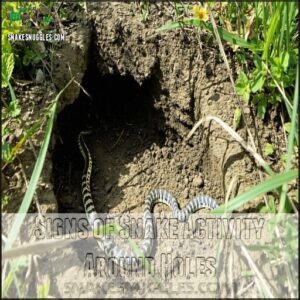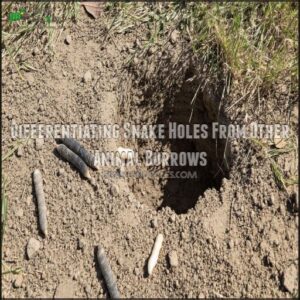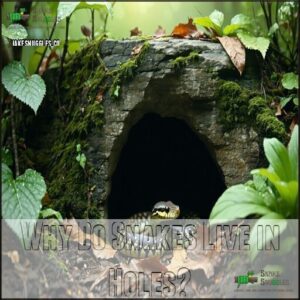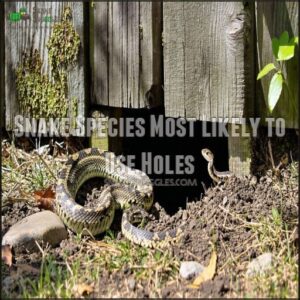This site is supported by our readers. We may earn a commission, at no cost to you, if you purchase through links.
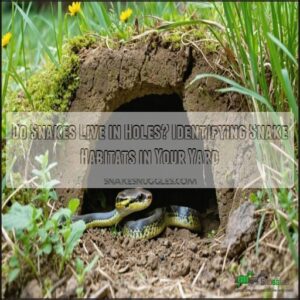 Snakes don’t dig their own holes, but they’re great at making themselves at home in ones left behind by other animals.
Snakes don’t dig their own holes, but they’re great at making themselves at home in ones left behind by other animals.
They often use abandoned rodent burrows, animal dens, or cracks in the ground as safe spots for hiding or resting. These holes help snakes stay protected from predators, regulate their body temperature, or even wait to ambush prey.
You might also find them under logs, rocks, or debris in your yard. So, while snakes don’t create holes, they certainly know how to use what’s available to stay protected from predators and regulate their body temperature.
Curious about spotting these holes or keeping snakes away? There’s more to discover about how snakes utilize abandoned burrows!
Table Of Contents
- Key Takeaways
- Do Snakes Create Their Own Holes?
- Types of Holes Snakes Commonly Inhabit
- Identifying Snake Holes in Your Yard
- Why Do Snakes Live in Holes?
- Snake Species Most Likely to Use Holes
- Preventing Snakes From Using Holes in Yards
- Frequently Asked Questions (FAQs)
- Are there snake holes in yards?
- Do snakes make holes in the ground?
- Where do snakes live if there are no ground holes?
- Do snakes eat holes?
- Can a snake burrow through a hole?
- Where can I find snake holes?
- Do snakes live in old burrows?
- Do rat snakes live in holes?
- Are Snakes Dangerous to Humans?
- What Can I Do to Keep Snakes Away From My Property?
- Conclusion
Key Takeaways
- Snakes don’t dig their own holes but rely on abandoned burrows, rock crevices, and natural shelters for safety and temperature control.
- Look for snake activity signs like shed skin, smooth hole edges, and nearby tracks to identify active holes.
- To keep snakes away, seal off burrows, trim vegetation, and remove food sources like rodents or standing water.
- Some snake species, like rattlesnakes and gopher snakes, use these holes for ambushing prey, hibernating, or laying eggs.
Do Snakes Create Their Own Holes?
Snakes don’t have the physical tools to dig their own holes but are skilled at using existing animal burrows.
In rare cases, certain species like sand boas can push through loose soil to create simple shelters.
Snakes’ Physical Limitations for Digging
Snakes simply aren’t built for digging. Their skeletal constraints and muscular weakness make moving soil impossible.
Built to slither, not dig—snakes rely on existing burrows, as their bodies lack the strength for soil excavation.
Unlike true burrowing animals, snakes rely on burrow dependence for shelter. Their anatomy, like smooth scales, adds scale friction against dirt, preventing efficient excavation.
Instead, they squeeze into pre-existing spaces, like tunnels or dens. Some species, however, exhibit remarkable burrowing capabilities.
- Snake burrows come from other animals, not their own digging.
- Smooth scales create friction, limiting soil movement.
- Their bodies excel at slithering, not digging.
- No specialized head structure exists for excavation.
- Snake habitats require existing underground spaces.
Adaptations for Using Existing Burrows
To thrive underground, snakes rely on finely tuned adaptations that make existing burrows ideal shelters.
Their elongated bodies and scales help them glide through rodent burrows effortlessly, conserving energy while seeking safety.
Snakes use their advanced senses to locate vacant spaces, modifying minimal features without significant digging.
Their bodies compress easily, allowing access to tunnels of varying Burrow Sizes.
By choosing snake burrows, they prioritize Predator Avoidance and Thermal Regulation, ensuring survival underground.
- Flexible bodies: Easily squeeze through confined spaces.
- Energy-efficient: Avoid Limited Digging by reusing spaces.
- Thermal Regulation: Stabilize body temperature underground.
- Predator Avoidance: Hide from threats.
- Competition-ready: Compete or cohabit if necessary.
Exceptions: Rare Cases of Snake-dug Holes
While most snakes rely on existing burrows, a few rare diggers stand out. Certain burrowing species, like king snakes, showcase surprising excavation adaptations.
Using their strong jaws and soil preferences, they carve small, temporary tunnels in loose dirt—though it’s not their go-to strategy. Gopher snakes also exhibit some digging prowess, occasionally creating simple burrows but often favoring abandoned rodent homes.
In contrast, rattlesnakes are less likely to excavate, preferring to modify existing snake habitats or dens instead of going through the effort of nest construction. Even rat snakes, which usually inhabit pre-made spaces, sometimes dig shallow depressions for egg-laying.
Some species, like common vipers, achieve remarkable hibernation depths to survive harsh winters. Nesting and reproduction seem to drive most digging behaviors in these rare cases. Recognizing these exceptions helps you better identify snake dwellings and manage pests responsibly in your yard.
Types of Holes Snakes Commonly Inhabit
Snakes often use existing holes in the ground, like abandoned rodent burrows or natural crevices, as safe hiding spots.
These spaces provide the shelter and cover snakes need to stay protected and survive in their environment.
Rodent Burrows as Snake Homes
Imagine a snake spotting a rodent burrow—it’s like finding a pre-furnished apartment.
These ready-made entrances are perfect for Burrow Takeovers, saving snakes energy and time. Since burrows are often near prey like mice or insects, they become ideal snake habitats.
- Hole Competition: Multiple snakes may target the same burrow for safety or hunting.
- Rodent Predation: The abundance of prey makes these burrows a natural hunting ground.
- Burrow Size: Most snakes inhabit tunnels just wide enough to squeeze through, ensuring snug protection.
Rodent holes offer snakes security, shelter, and endless dining opportunities—all without lifting a “shovel.
Abandoned Animal Dens Used by Snakes
When an animal abandons its den, it often becomes prime real estate for burrowing snakes.
These creatures excel at burrow takeover, cozying into vacated homes left by rodents, armadillos, or even foxes.
Snake dens provide safety, temperature control, and solid downtime spots with minimal effort on their part.
Here’s an example:
Den Type Size Location Defense
Natural Cavities in Rocks and Soil
Natural shelters like rock crevices and erosion-made cavities give snakes cozy homes with minimal effort.
These spaces often maintain stable microclimates and provide protection from predators.
You’ll find them in places with the right soil composition and naturally snug crevices.
Check for these clues to spot active snake holes:
- Shed skin scattered near the entrance
- Dark feces with a telltale white tip nearby
- Lack of spiderwebs blocking the opening
- Smooth entrances, free from claw marks
- Disturbed soil, hinting at recent use
These habitats offer snug, ready-made retreats for snakes to live safely.
Spaces Under Fallen Logs and Debris
Fallen logs and debris make excellent snake shelters, blending effortlessly into the landscape of a snake’s natural habitat.
These hidden habitats provide consistent moisture, warmth, and safety from predators, creating what experts call log microclimates.
For many snake species, rotting wood is perfect for skin shedding and comfort.
You might find snakes tucked under leaf piles, branches, or fallen logs, making temporary or permanent homes depending on their needs.
These debris ecosystems offer not just protection but also access to prey, like insects and smaller animals.
Snakes often utilize pre-existing holes made by other animals.
- Rotting logs and debris: Prime snake living spaces, offering humidity, shade, and safety.
Leaving cluttered areas undisturbed in your yard often turns them into inviting snake hideouts, blending seamlessly into nature’s shelter affordances.
Identifying Snake Holes in Your Yard
You can spot snake holes in your yard by paying attention to their size, shape, and surrounding signs.
These holes are usually small, round openings with smooth edges and may show signs of snake activity like shed skin or faint tracks nearby, which can be critical signs to identify snake holes.
Size and Shape Characteristics
Snake holes are easy to spot once you know what to look for.
These entrances, often clean-edged and smooth, feature circular or slightly oval shapes.
Their sizes fall within a diameter variation of 2 to 4 inches, just enough for most snakes.
Unlike rodent burrows, there’s no mess—no scattered dirt or claw marks.
Snakes prefer ready-made shelters that blend into their surroundings.
Here’s a quick reference:
| Feature | Snake Holes | Rodent Holes |
|---|---|---|
| Hole Shape | Circular or oval | Irregular, messy |
| Entrance Cleanliness | Smooth edges, no debris | Claw-marked, disturbed soil |
| Diameter | 2-4 inches | Varies, often larger |
| Edge Characteristics | Neat, undisturbed | Jagged, uneven |
Signs of Snake Activity Around Holes
Wondering if a snake’s made that hole its home? You can spot the signs with keen observation:
- Shed snakeskin snagged near the entrance. It’s a surefire clue.
- Snake tracks in loose dirt, showing their comings and goings.
- Feces identification, featuring dark droppings with white tips nearby.
- No spiderwebs or debris, meaning the hole’s in active use.
Snake hole identification takes practice, but small details like these make all the difference when spotting their activity.
Differentiating Snake Holes From Other Animal Burrows
Telling snake holes apart from other animal burrows isn’t as tricky as it might seem if you know what to look for.
Start with the hole size—snake holes are usually small, 0.5 to 3 inches wide, with a round or oval entrance. The edges are smooth, without claw marks or messy heaps of soil, unlike rodent burrows.
Active track identification is key, too. Check for faint slither marks nearby or in soft dirt. You might spot snake droppings, which are dark with white tips, close to the opening.
Snake holes also lack spiderwebs or debris blocking the entrance, suggesting current use. When in doubt, consult animal control for safety.
Common Locations for Snake Holes
You’ll find snake holes where grass and dirt, warmth, and safety meet.
Snakes in holes favor areas that offer protection and easy hunting opportunities.
These spots often include:
- Under logs: Perfect shelters that provide shade and hiding places.
- Rock walls and structural cracks: Ideal for temperature control and avoiding predators.
- Concrete spaces: Areas like foundations or decks offer safety from disturbance.
Snakes in burrows, like old rodent holes, also enjoy these ready-made homes.
Snake dens blend into their environment, making careful observation important.
Why Do Snakes Live in Holes?
Snakes use holes for protection from predators, harsh weather, and extreme temperatures. These spaces also serve as safe spots for hunting, hibernating, and raising their young.
Protection From Predators and Elements
Snake holes aren’t just random spots underground—they’re carefully chosen for safety and comfort.
Snake holes serve as nature’s ultimate refuge, ensuring safety, comfort, and survival in a carefully chosen underground sanctuary.
For snakes in burrows, these spaces offer a powerful predator avoidance tool, keeping them hidden from sharp-eyed hawks or crafty mammals. Think of it as nature’s version of a panic room.
Beyond the camouflage advantage, these dens serve as seasonal shelters against harsh weather. Whether it’s blazing summer heat or relentless rain, snakes in holes find stable conditions, thanks to a burrow microclimate.
These underground refuges shield them from dehydration while maintaining their skin’s moisture and health. Some snakes also use aposematic coloration to deter predators.
Snakes underground may also borrow abandoned dens or rock crevices, adapting to whatever offers them privacy and safety. It’s a simple yet effective survival strategy they rely on year-round.
Temperature Regulation and Hibernation
Many snakes survive cold months with impressive thermoregulation, relying on hibernacula (winter shelters) to maintain warmth. As ectothermic creatures, they depend on external heat during winter dormancy, entering brumation—a sluggish state similar to hibernation.
Underground burrows provide thermal shelters, shielding snakes from freezing while guaranteeing survival.
Here’s how brumation works:
- Their metabolism slows, letting them last months without food.
- Burrow temperatures stay stable, preventing dangerous chills.
- They occasionally drink water or adjust positions to stay comfortable.
Through cold tolerance, these shelters guarantee snakes safely await seasonal migration or warmer basking behavior.
Hunting Strategy and Ambush Points
Snake holes, often abandoned rodent burrows, are ideal ambush locations for hunting.
These serve as strategic hiding spots, allowing snakes to use their camouflage tactics and patience to lure prey into strike range. With minimal movement, snakes rely on venom usage for quick immobilization.
Here’s how snake holes aid ambush hunting:
| Feature | Benefit |
|---|---|
| Hidden Position | Avoids predator detection |
| Proximity to Prey | Attracts small rodents easily |
| Minimal Movement | Conserves energy |
| Secure Feeding Zone | Guarantees uninterrupted feeding |
Snake behavior in these habitats highlights their adaptability and efficiency.
Nesting and Breeding Purposes
A hole isn’t just a hideout—it’s where life begins for many snakes.
Females use secure snake holes, like old rodent burrows, for egg deposition. These snug shelters create ideal conditions for incubation, ensuring proper temperatures for growing clutches.
Hatchling emergence depends on these hidden havens, which shield babies from predators. While snakes don’t offer parental care, their choice of a nest directly impacts survival.
Snake behavior showcases how snake ecology adapts to every corner of their environment.
Snake Species Most Likely to Use Holes
Some snake species, like rattlesnakes, gopher snakes, and king snakes, commonly use holes for shelter, hunting, or hibernation.
Their choice of burrows often depends on local habitat conditions and the availability of pre-dug spaces.
Rattlesnakes and Their Den Preferences
Rattlesnakes are experts at making the most of existing spaces. They use abandoned rodent burrows as their hibernacula, perfect for regulating body temperature and protection.
These snake dens often serve as winter homes where multiple rattlesnakes gather, a behavior called den sharing. You’ll usually find them in rocky, loose soil areas, hidden and undisturbed.
Rattlesnakes prefer dens about 3 to 6 feet deep, ensuring stable conditions year-round. Signs of active dens include nearby slither tracks or the telltale sound of a rattle.
Geographic variations influence their choices, showcasing their fascinating hibernation habits.
- Look for snake holes in rocky regions.
- Active dens lack cobwebs.
- Venomous snakes need cautious handling.
Gopher Snakes and Burrow Utilization
Gopher snakes are masters at using abandoned rodent burrows, adapting them for safety and stable temperatures.
Their muscular bodies make traversing these snake holes effortless, even in tight tunnels.
These burrowing snakes thrive in subterranean habitats by reducing pests and competing for burrows effectively, which is a key part of their hunting strategy.
With clever burrow adaptations, they share tunnels close to prey, ensuring survival.
By observing gopher snake burrows, you’ll see how their resourcefulness supports their ability to avoid predators underground.
King Snakes’ Hole-dwelling Habits
King snakes are fascinating burrowing snakes that prefer existing holes over digging their own.
These adaptable reptiles choose burrows strategically, balancing their habitat preferences with the need for protection and hunting.
They often select medium-sized rodent burrows that offer shade, stable conditions, and escape routes for safety.
- Burrow defense: King snakes fiercely protect their space from threats.
- Diet inside burrows: They use snake holes as ambush points for prey.
- Co-inhabitants: Sometimes, they share burrows with non-venomous neighbors.
- Habitat preferences: Favored burrows provide shelter and regulate body temperature.
These snakes in holes thrive underground, blending survival instincts with adaptability.
Regional Variations in Hole-dwelling Snake Species
Snakes adapt their burrowing behavior based on local ecosystems and climate adaptations, creating diverse strategies for survival.
In deserts, species like sidewinders avoid the scorching heat by sheltering in shaded snake holes, while coastal snakes use sandy burrows near water.
Mountain species tuck into rocky crevices, blending with their natural habitat for safety.
Prey availability often influences burrowing snakes’ chosen habitats, as they rely on proximity to food.
However, habitat loss and invasive species threaten many snake species, disrupting their role in nutrient cycling and local ecosystem balance.
Protecting these habitats guarantees ecological harmony.
Preventing Snakes From Using Holes in Yards
You can keep snakes from using holes in your yard by making the area less inviting and addressing existing burrows.
Simple steps like sealing holes, removing food sources, and maintaining clean, open spaces can discourage them effectively.
They can be discouraged by maintaining clean, open spaces.
Sealing and Filling Existing Holes
If you’ve spotted snake holes in your yard, filling them is a key step in snake prevention.
Before you start, check for signs of current residents—use a flashlight and work cautiously.
Once the hole is clear, choose a filling material like gravel mixed with soil for effective sealing.
This helps block snakes and addresses rodent problems too.
Many homeowners find success using specialized products for this.
To guarantee success, try these blocking techniques:
- Snake hole covering: Use heavy-duty wire mesh for larger holes before filling with soil.
- Professional sealing: Eco-friendly sealants offer humane considerations for wildlife.
Pack materials tightly to remove gaps and create long-term solutions.
By addressing snake hole filling thoughtfully, you prevent unwanted guests and also keep your yard safer and snake-free.
Removing Attractants and Food Sources
Stopping snakes starts with targeting their food chain. Rodent control is your first step—secure trash cans, store pet food indoors, and clear fallen fruit to limit rodent problems.
Insect removal is just as key, so reduce water sources like puddles that attract bugs. Cleanup matters too—clear debris like woodpiles and trim overgrown vegetation to remove inviting spots for pests.
Avoid placing bird feeders near your home, as spilled seeds attract rodents. Effective strategies include using various rodent solutions to manage the population.
Cutting off these resources keeps snakes from seeing your yard as a buffet, which is a crucial step in stopping them, by targeting their food chain and using effective rodent control methods, including securing trash cans and storing pet food indoors to limit rodent problems.
Landscaping Techniques to Deter Snakes
A snakeproof yard starts with thoughtful habitat modification.
By making simple tweaks, you can keep snakes far from your property. Start with these key steps:
- Repellent Plants: Add snakerepelling plants like marigolds, lemongrass, or wormwood. These natural barriers deter snakes beautifully. Consider exploring options for snake repellent plants to enhance your yard’s defenses.
- Water Management: Fix leaks, install proper drainage, and eliminate standing water to remove attractive shelter spots.
- Fencing Options: Use mesh barriers, gravel, or tightly woven fences along borders to block snake entry.
Combine these strategies with regular maintenance—like trimming dense ground cover—and you’ll encourage snakes to slither elsewhere while enjoying a safer, snake-resistant landscape.
Professional Snake Exclusion Methods
If snakes still linger after your landscaping adjustments, calling in professionals guarantees peace of mind.
Expert wildlife control teams specialize in humane snake removal using professional deterrents like sturdy fencing and skilled expert hole sealing. They conduct thorough wildlife inspections, identifying problem areas and tailoring solutions like habitat modification to eliminate attractants.
By addressing every detail, professionals guarantee effective snake relocation and long-term prevention. Their focus on wildlife removal balances safety with ecosystem health.
Investing in professional snake removal means your yard is protected without risking unnecessary encounters—you’re free to enjoy your space worry-free. To further discourage snakes, consider eliminating food sources around your property.
Frequently Asked Questions (FAQs)
Are there snake holes in yards?
Yes, your yard might’ve snake holes, especially in loose soil, tall grass, or under rocks.
Snakes use existing burrows for shelter, often leaving behind shed skin or faint tracks near the entrance, which can be a key indicator of snake activity.
Do snakes make holes in the ground?
Imagine a snake as a tenant, not a builder.
They don’t dig their own holes but move into pre-made ones, like abandoned rodent burrows or natural crevices.
These cozy spots suit their needs perfectly!
Where do snakes live if there are no ground holes?
If there aren’t ground holes available, snakes seek shelter in rock crevices, hollow logs, dense vegetation, or under debris.
They prefer spots offering safety, warmth, and access to prey for hunting and survival.
Do snakes eat holes?
They don’t eat holes—snakes use pre-existing burrows or crevices for shelter.
They rely on holes dug by other animals like rodents.
Instead of digging, they slither in, making themselves right at home.
Can a snake burrow through a hole?
Snakes don’t dig their own holes but can squeeze through and inhabit existing ones.
They slither into burrows left by rodents or insects, favoring spots with loose soil, cover, and easy access to prey.
Where can I find snake holes?
Beneath fallen logs, dense shrubs, or in loose soil near water, you’ll spot telltale snake holes—round, tidy openings often hidden in nature’s clutter.
Look for shed skin nearby to confirm a snake’s residence.
Do snakes live in old burrows?
Yes, snakes often move into old burrows left by rodents or other animals.
These ready-made shelters are cozy, hidden, and provide protection from predators, making them an ideal choice for many snake species, with ready-made shelters being a key factor.
Do rat snakes live in holes?
When push comes to shove, rat snakes do sometimes take up residence in holes, especially abandoned rodent burrows.
They don’t dig their own, but instead use pre-made spaces, like crevices, for shelter and nesting.
Are Snakes Dangerous to Humans?
Not all snakes are dangerous, but venomous ones like rattlesnakes or copperheads can harm you if provoked.
Most avoid humans and only strike in defense.
Stay aware, respect their space, and you’ll avoid trouble.
What Can I Do to Keep Snakes Away From My Property?
Don’t worry—it’s easy to keep snakes at bay!
Mow your lawn, clear debris, and seal gaps in your home’s foundation.
Remove rodent attractants, like food scraps, and use snake-repelling plants or mesh barriers strategically.
Conclusion
It’s ironic that snakes, with no digging skills of their own, thrive in holes they didn’t create.
By claiming abandoned burrows, natural crevices, or spaces under logs, they find shelter, regulate their temperature, and sometimes ambush prey.
If you’re wondering, “Do snakes live in holes?”, the answer is yes—but they’re expert tenants, not builders.
To keep your yard snake-free, seal gaps, remove debris, and address prey populations, ensuring these adaptable reptiles don’t move in uninvited.
- https://www.thespruce.com/snake-holes-in-yard-8640337
- https://www.msn.com/en-us/lifestyle/pets/12-common-mistakes-that-turn-your-yard-into-a-snake-paradise/ss-AA1yOxmB?cvid=d115c858c71049d2a8a12c4e92d2cf42&ei=4
- https://www.housedigest.com/1556674/birdbath-attract-snake-pest-yard/
- https://www.facebook.com/forfoxsakewildlife/posts/what-kind-of-snake-made-this-holeits-one-of-the-more-common-questions-on-the-int/871269268505404/
- https://animals.mom.com/deep-can-snakes-underground-7143.html


